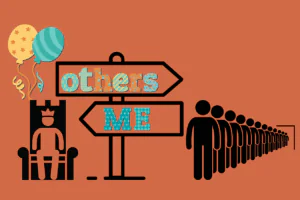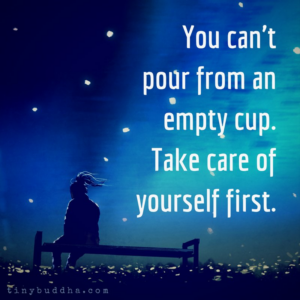guest post by Jennifer Mehochko, LCPC, SEP
Have you heard of codependency? It is a surprisingly serious condition that usually develops in childhood, when you learn that it is not safe or ok to focus on yourself. This can create many issues later in life if you don’t develop a healthy sense of your Self. But how do you even know if you or a loved one suffers from codependency?
The crux of codependency is when you consistently put others’ feelings ahead of your own and invariably provide for others’ needs before your own, even at the expense of your own health and well-being. While there isn’t a recognized codependency disorder or codependency personality disorder, its signs and symptoms are well-recognized in the mental health field.
Often codependency arises in an environment where there is some combination of abuse, neglect, trauma, absent parents, divorce, arguing, fighting, drug/alcohol abuse, and/or other addictions. The child learns that they feel better, safer, or just more “ok” when they are focusing on pleasing the parents or others in their family.
From this standpoint, codependency is a master survival strategy. Your nervous system is so beautifully designed to help you survive whatever discomfort or chaos is going on in the environment around you, that the “fawning” response kicks in. And fawning is the foundation of codependency.
Other survival responses might include “fight”, “flight”, or “freeze”, and certainly your nervous system may vacillate between these responses, but if your primary survival technique tends to be the “fawning” response, codependency develops if left unchecked.
Codependency Signs
Signs, symptoms, and indicators of codependent behavior can include:
- Poor boundaries with others (i.e. offering advice even if it isn’t asked for)
- Low self-esteem
- Caretaking, even when the other is able to take care of themselves
- Obsessions
- A need for control
- Difficulty making decisions, often combined with excessive opinion-gathering
- Difficulty adjusting to change
- Expecting others to do as you say
- Feeling used and underappreciated
- Trouble identifying or communicating thoughts, feelings, or needs
- Chronic anger or strong emotional reactions
- Routinely putting others’ needs before your own
Codependency Disorder
In the Adverse Childhood Experiences study, researchers found that codependent tendencies can arise from experiencing traumatic events in childhood. The more traumatic events a person has experienced (including death of a parent, physical abuse, emotional or sexual abuse, physical neglect, mental illness of a relative, incarcerated relative, witnessing their mother being treated violently, substance use in the home, and divorce) the more likely they are to develop health issues and emotional issues, like codependency, over the course of their life.
Originally, codependency became popular in the 1940’s to describe the behavioral responses to living with someone who was addicted to drugs or alcohol. Since then, we’ve discovered that complex trauma, which is many layers of trauma over time in childhood, can lead to difficulty connecting with the self. Growing up in a family where others don’t see, hear, or understand (know) you, the child you learn to disconnect from yourself. You may even form a “trauma bond” with someone who is abuses, dismisses, or invalidates you. As a result, you learn that you can’t trust yourself.
Codependency is sometimes called “relationship addiction.” This is because through fawning behavior you haven’t learned that you have your own boundaries and sense of self. So, as a result, you inadvertently allow others to violate or take advantage of you in various ways. Or you may have learned that you need to cling to anyone who will even look in your direction. Often you can be easily manipulated by people to do things for you.
So, what’s the cost of codependency? A good metaphor to understand this is your car. When your car engine keeps running and running without changing or adding new oil, it eventually will begin to break down and finally stop running. Similarly, if you are codependent, you will eventually begin to experience breakdown in various areas of your life. For example, you might suffer emotionally with depression, anxiety, panic, fear, etc. You are also much more likely to develop serious health problems, such as autoimmune disorders, cancer, addiction, adrenal fatigue, irritable bowel, and so on.
Codependency Therapy
Because the cost of codependency is so great, codependency healing is vitally important. Therapy for codependency can assist you in navigating the relational challenges that you encounter daily – mostly by learning to set better boundaries for yourself. While boundary-setting is often not easy, it can be learned, and allows you to have better relationships and more freedom to engage in self-care.
Learning that one can prioritize yourself and your needs is pivotal to recovery from codependency. Many of my clients have come to understand that they are NOT being “selfish” when taking care of themselves. Rather they are being kind and compassionate to themselves when they prioritize and treat themselves with care.
In addition, immense benefits are gained when you take better care of yourself. Others around you, especially family and friends, will reap the benefits of having a more attuned, present, and available loved one!
If you recognize the signs of codependency in yourself or a loved one but are not sure where to start with boundary setting and moving forward, check out the resources below. If you’re in Illinois, the therapists at Life Care Wellness are here to help you. Please reach out to us in our Glen Ellyn, Chicago (Jefferson Park), Sycamore, or Yorkville locations.
Resources
A helpful alternative or adjunct to codependency therapy can be participation in a Twelve Step fellowship. Codependents Anonymous can offer a tremendous support in learning to set boundaries and disengage from codependent behavior. Also, if there is an addiction present in your home, the “Anon” programs for family members and friends can offer similar support in learning to let go of codependency. Al-Anon, Nar-Anon, Gam-Anon, and S-Anon are some of these.
If you want to learn more about codependency, the books and resources by Pia Melody and Melody Beattie are some of the best out there, such as Codependent No More, The New Codependency, and Facing Love Addiction. Other great resources are Boundaries by Dr. Henry Cloud and John Townsend and Codependence and the Power of Detachment by Karen Casey.
Some great Podcasts and social media resources on codependency are by Lisa A. Romano, Dr. Ramani Durvasula, Leslie Vernick, and Dr. Les Carter.
Jennifer is a Licensed Clinical Professional Counselor (LCPC) and believes in a holistic approach to therapy. She interweaves body-oriented and attachment-based support and repair into all her work with clients, which allows for a rich, gentle, connection-based healing approach. Jennifer’s education includes a master’s degree from the Adler School of Professional Psychology and a bachelor’s degree in Psychology from Illinois State University. She is also a Somatic Experiencing Practitioner and is trained in the use of therapeutic touch. Jennifer has experience in a variety of mental health and substance abuse treatment settings.






